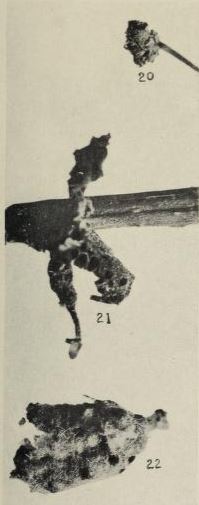Neuroterus tectus (sexgen)
Neuroterus tectus form tectus [sexgen]
Galls. — Small swellings (Figs. 20 to 22) of the stems of flower clusters, of petioles, or of young stems of oak. Each swelling consists of closely-packed clusters of thin- walled, oval larval cells, each measuring about .7X1.2 mm. with a thin covering of distorted bark, there being little other hypertrophied tissue present. Usually covered with gray pubescence. On Quercus prinoides (and Q. alba?).
Range: MA, CT, PA, RI, NY, NJ
These galls are very inconspicuous productions, hardly to be observed until the tiny exit holes made by the insects may be found in the stems of the flower clusters. The insects emerge late in May and early in June, after only a month spent in the galls. Bassett found the adults mostly emerged by June 10.
Neuroterus tectus form abundans, new name [agamic]
Galls. — Not certainly identified. Most likely swellings very similar to the galls of the bisexual generation, but on the midvein of the young leaves, somewhat distorting the whole leaf.
Range: MA, CT, PA, RI, NY, NJ
The eggs which produce this form of the species are laid early in June by the female of the bisexual generation. It is not certain what sort of galls are produced. Galls of the above description, in the Thompson Collection, belong, I believe, to the females of this generation, but the data was not distinctly affixed. From what is known of the life history of the species, it is evident that this generation lives in the galls for about ten and a half months, emerging and ovipositing April 29 (Bassett) to May 10 (Thompson). As far as known, the generation is agamic. The females very closely resemble the females of the bisexual generation but are readily distinguishable by the larger, more oval abdomen, a character to be expected in the agamic generation.
The material on which I base this data was obtained by the late Millett T. Thompson, whose collection of gall-insects is now in the Museum of the Boston Society of Natural History. The females marked “F” in the collection were found ovipositing May 10, 1907, in buds of Quercus prinoides, the points of oviposition were marked, the galls produced were bred and the females and males of the bisexual generation obtained. This material, distinctively labelled, is now in the Boston Society collections and in the author’s collections.
These observations are in accord with those made by Bassett concerning the similarity of the two generations as he had found them, but Bassett did not mark the points of oviposition of the agamic form, nor did he note the differences in the two generations and keep them sepa- rate in his collections. The female “tectus” as Bassett described it, was apparently the agamic female, but the description of the abdomen as “small, in outline an equilateral triangle,” applies distinctly to the female of the bisexual generation ; while among the Bassett cotypes are females of both generations. Inasmuch as the male and the distinctive gall of the bisexual generation were called tectus, I use that name to designate that generation, and abundans describing the larger-bodied female, for the agamic generation.
I feel fortunate in being able to present the life history of this species, because it gives another instance of the very slight differences between the successive generations of the species of Neuroterus and, further, bears out my belief that alternation of generations is merely a development of seasonal dimorphism. It is very much to be desired that we closely observe other species of Neuroterus and try to discern still more primitive instances of dimorphism, or of a double-brooded condition without an accompanying heterogeny, among the species of the group.
”- Alfred Charles Kinsey: (1920) Life histories of American Cynipidae©
Reference: https://www.biodiversitylibrary.org/item/213997#page/22/mode/1up


